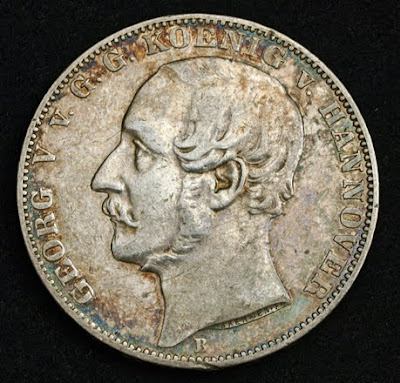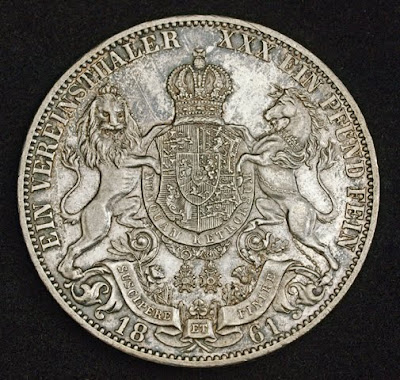 |
| German Coins, Kingdom of Hanover Silver Vereinstaler of 1861, King George V. |
 |
| German Coins, Kingdom of Hanover Silver Vereinstaler of 1861. |
The Vereinsthaler - Union Thaler - was a standard silver coin used in most German states.
Obverse: Head of George V. left. Engraver´s name (BREHMER) at base of truncation.
Legend: GEORG V v. G. G. KOENIG v. HANNOVER / B
Reverse: Crowned heraldic arms of the House of Hanover, supported by Unicorn and Lion.
Banner Legends in Latin: NUNQUAM RETRORSUM / SUSCIPERE ET FINERE
Translated Banner Legends: "Never to retreat!" / "To undertake and accomplish!"
Legend: EIN VEREINSTHALER XXX EIN PFUND FEIN / 18 61
References: KM-230.
Weight: 18.49 gm
Diameter: 34 mm
German Coins, German coinage, German silver coins, German States Coins, Coins of Germany, German Gold Coins, German commemorative coins, German Imperial Coins, Numismatic Collection, Coins of the German Empire, Coins of Germany best silver coins for investment, silver coins, German East Africa coins, old coins, coin collecting, rare coins, world coins, foreign coins, heritage coins, silver ira investment, silver bullion coins, silver coin collection investors, investment coins, antique coins, Unique Silver Coins, collectible coins, Münzen Deutschland, silbermünzen, Münzen aus Deutschland, Münzen Deutsches Kaiserreich.
Hanoverian vereinsthaler
The Vereinsthaler was the currency of the Kingdom of Hanover between 1857 and 1866. The Vereinsthaler replaced the prior Thaler at par. The Vereinsthaler was first subdivided into 24 Groschen, each of 12 Pfennig, thus 288 Pfennig = 1 Vereinsthaler. From 1858 on the subdivisions were more decimalised to 30 Groschen, each of 10 Pfennig, thus 300 Pfennig making up a Vereinsthaler.
When in 1866 the Kingdom of Prussia annexed Hanover the Hanoveran currency was replaced by the Prussian Vereinsthaler, subdivided into 30 Silbergroschen, each of 12 Pfennig (thus 360 Pfennig = 1 Pr. Vereinsthaler).
George V of Hanover
George V (George Frederick Alexander Charles Ernest Augustus; German: Georg Friedrich Alexander Karl Ernst August; 27 May 1819 – 12 June 1878) was the last king of Hanover, the only child and successor of King Ernest Augustus I. George V's reign was ended by the Unification of Germany.
During his 15-year reign, he engaged in frequent disputes with the Hanoverian parliament. Having supported Austria in the Diet of the German Confederation in June 1866, he refused, contrary to the wishes of his parliament, to assent to the Prussian demand that Hanover should observe an unarmed neutrality during the Austro-Prussian War. As a result, the Prussian army occupied Hanover and the Hanoverian army surrendered on 29 June 1866, the King and royal family having fled to Austria. The Prussian government formally annexed Hanover on 20 September, but the deposed King never renounced his rights to the throne nor acknowledged Prussia's actions. From exile in Gmunden, Austria, he appealed in vain for the European great powers to intervene on behalf of Hanover. From 1866, George V maintained the Guelphic Legion at his own expense.
George V died at his residence in the Rue de Presbourg, Paris, in June 1878. He was buried in St George's Chapel at Windsor Castle.